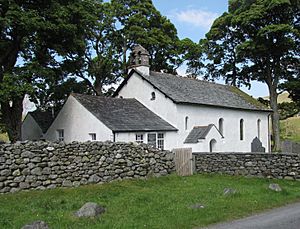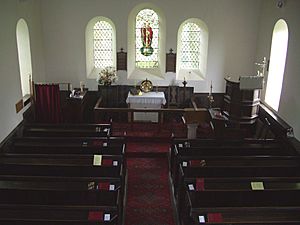Newlands Church facts for kids
Quick facts for kids Newlands Church |
|
|---|---|

Newlands Church with the former school building to the left
|
|
| Location | Little Town, Cumbria |
| Country | England, United Kingdom |
| Denomination | Anglican |
| History | |
| Status | Church |
| Founded | Unknown, but possibly 16th century |
| Architecture | |
| Functional status | Active |
| Heritage designation | Grade II |
| Specifications | |
| Materials | Roughcast |
Newlands Church is an old church from the 1500s. It is found in the beautiful Newlands Valley of the Lake District in England. The church is just a short walk west of a small village called Little Town, Cumbria.
No one knows the exact year the church was built. However, a map from 1576 already showed a "Newlande Chap." on this spot. The church has white walls and a green roof made of slate. Inside, you can see two special stained-glass windows. There is also a balcony and a reading desk and pulpit from 1610. Many visitors and walkers stop by the church on their way to the nearby mountains. Newlands Church is a Grade II listed building, which means it is an important historical building.
Contents
Where is Newlands Church?
Newlands Church is in a quiet countryside area. It is about 500 meters west of Little Town, Cumbria. This spot is in the Lake District National Park. It is also about six miles by road from Keswick. The church sits in the Newlands Valley. High mountains surround the valley, making it a very scenic place.
History of Newlands Church
How the Church Started
The exact start date of Newlands Church is a mystery. People believe it was built around the mid-1500s. A map by Christopher Saxton from 1576 shows a church here. It was called "Newlande Chap." back then.
In 1594, a local farmer named John Mayson left money to "Newlandes Chappell" in his will. For a while, the church did not have a main priest. This was partly due to the plague in 1558. In 1610, Anthony Bragg became the church's first Lay reader. A Lay reader was a local person who could lead services. However, they could not perform baptisms, weddings, or Communion. A main priest would visit the valley to do these special duties. Nine Lay readers served the church until 1731.
Early Church Leaders
In 1731, Joseph Fisher became the church's first Curate. He served until 1779. Newlands was a poor church, with a very low annual payment for its leaders. The church received some money from a fund called Queen Anne's Bounty. This helped it financially in the 1700s.
Ten Curates served Newlands Church until 1868. One of them was William Parsable, who served for 32 years. He was also a headmaster at a school in Keswick. He was known for being strict with both his church members and his students.
Rebuilding and New School
By the early 1840s, the church building was in poor condition. John Monkhouse became the Curate in 1840. He worked hard to raise money to rebuild the church. He also wanted to add a school.
The school was built next to the church in 1841. It cost £37 to build. A sign outside the school today says 1877, but records show it was built earlier. The church itself was rebuilt for £200. This included a new roof and new windows. The building was made taller, which allowed for a balcony to be added inside.
From the 1880s to Today
In 1882, Newlands Church got its first vicar, A.C. Forbes. In 1885, more improvements were made. New seats, new flooring, and a heating system were installed. A special slate plaque was placed in the north wall to remember this reopening. The church's graveyard was made larger in 1926.
The school stayed open until 1967. After that, students went to Braithwaite Primary School. The old school room was not used for a while. But in the late 1990s, it was fixed up. It reopened on April 9, 2000, as a quiet place for people to think. Today, church services are held twice a month. The church is also open during the day for visitors and walkers to stop by. It remains a Grade II listed building.
Inside the Church
At the front of the church, you will find a reader's desk and a pulpit. Both of these pieces are from 1610. The lectern, which holds the Bible, is made of sandstone and wood. It was added in 1937. The wooden top can be removed, so the stone base can be used for baptisms.
The stained-glass window at the east end of the church is from 1845. Local people paid for it to celebrate the church's rebuilding. It shows Jesus holding wine and bread. The words "I am the true vine, I am the living bread" are also on the window. Another stained-glass window is in the middle of the south wall. It shows St Michael in armor. This window remembers Thomas Roscre Johnston, who died in World War I.
A slate plaque on the north wall remembers the church's reopening in 1885. There are also memorials to people who helped the church, like Moses and Sarah Mawson. Other memorials remember the Clark brothers, who died in World War II. A wooden shield with the Royal Coat of Arms of George II from 1737 hangs on the south wall.
Literary Connections
The famous poet William Wordsworth and his daughter Dora visited Newlands Church in May 1826. They were on a walking trip from Rydal Mount. Wordsworth was very impressed by the church. He saw it through the leaves of the trees. This inspired him to write a poem called "To May":
- "How delicate the leafy veil
- Through which yon house of God
- Gleams, mid the peace of this deep dale
- By few but shepherds trod!"
In the summer of 1901, the children's author Beatrix Potter stayed nearby. She often had the vicar of Newlands Church and his family over for tea. The vicar's young daughter, Lucie Carr, played with Potter's pet hedgehog. This inspired the character of Lucie in The Tale of Mrs. Tiggy-Winkle (1905). In one picture from the book, Potter even drew the church in a group of trees.



